It looks like you're using an Ad Blocker.
Please white-list or disable AboveTopSecret.com in your ad-blocking tool.
Thank you.
Some features of ATS will be disabled while you continue to use an ad-blocker.
share:
Originally posted by LeftBehind
So she withstood the heat by not being there when the fires were raging later on.
There is no evidence that the fires got progressively worse. quite the contrary. Just watch the video real time raw footage and this is quite evident.
Jones take on the picture of glowing metal is entirely his opinion. Considering the quality of research he's shown, perhaps we shouldn't treat his opinions as gospel. He is saying that the temperature of the metal is between 1500-1900 F? Where does he get that figure from? I don't see any thermometers in the picture so he must have pulled that one from the same place he pulled his 4000lbs of explosives calculation.
Just because you are ignorant about physics and too lazy to read the sources he cites doesn't mean you have a right to slander an actual Professor. You most certainly can tell metal temperature by color. Here is the chart he cites:
Color............................ Approximate Temperature
......................°F.......... °C .........K
Faint Red................930 500 770
Blood Red..............1075 580 855
Dark Cherry................1175 635 910
Medium Cherry.............1275 690 965
Cherry..........................1375 745 1020
Bright Cherry.................. 1450 790 1060
Salmon............................ 1550 845 1115
Dark Orange....................... 1630 890 1160
Orange...........................1725 940 1215
Lemon............................ 1830 1000 1270
Light Yellow.................... 1975 1080 1355
White............................. 2200 1205 1480
While he is correct that aluminum would be runny at 1500-1900 F, It could be much lower than that and still be semi molten aluminum. It really doesn't make much sense that they would be dipping buckets made of steel into molten steel. Notice the lack of damage to the bucket in this 1900 degree envirnonment.
The molten steel glob or slag in that pic was pulled up with a bunch of debris. Obviously throughout the clean up they were discovering these pools and probably letting them cool before cleaning them up further. It all makes perfect sense. And the point is that the salmon color is much too hot to be aluminum which would never get to that color. Furthermore......there could be continuous thermite reactions going on in the pools. Professor Jones made that point but here is another quote saying the same thing:
Thermite is a dynamic reaction that can be ongoing as long as material is present to react. Therefore we have our Aluminium...our Iron III Oxide...reacting under the pressure of the rubble pile generating heat....thus our molten metal.
Someone esle once asked the following question, I saw no response to it so I thought I would repeat it.
Why is NIST unreliable when presented as evidence against demolition, but swallowed up when it can be twisted to support demolition?
Why do you guys accept NIST figures on anything? After all their conclusion was a gravity driven progressive collapse.
This is a logical fallacy/circular argument/ pointless question. I think it was bsbray that answered and said that it is a debate method to debunk you with your own source. Obviously we feel that the NIST report is a biased effort to prove an already pre-determined conclusion. So naturally if this is the case but even THEIR data supports the inside job theory....well you must get the drift by now.
Originally posted by count zero
About the molten hot steel. This is six weeks later. Its mere existence should send shivers down your spine. No matter how you look at it, it should not exist, yet satellite photos prove its existence.
The core columns were 54 inches by 22 inches by 5 inches thick. It would take some force to bring down 47 of them simultaneously. That force would provide the heat intensity to melt them, but not a fire 75 floors or more up.
The "official" story is absurd!
This is not to be ignored. Do not cite coal fires to me, there is no
way office contents maintained such a hot fire for so long without
the benefit of oxygen. Comparing oxygenated coal mines to the
basements of WTC 1 & 2 is ignorant.
What the # are you talking about? Coal fires?
Originally posted by XenonCodex
Hey Genius's!
;lol:
Originally posted by XenonCodex
Did you see the girl standing "unscathed" in the North Tower photo?
Oh, my you are right, that looks like a really "cool" fire there.
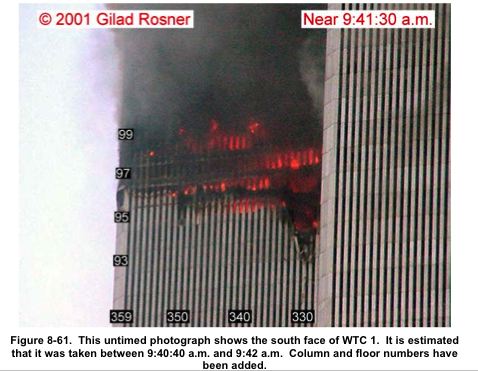
If you look closely, you can see that the exterior columns on the south face are starting to buckle inward.
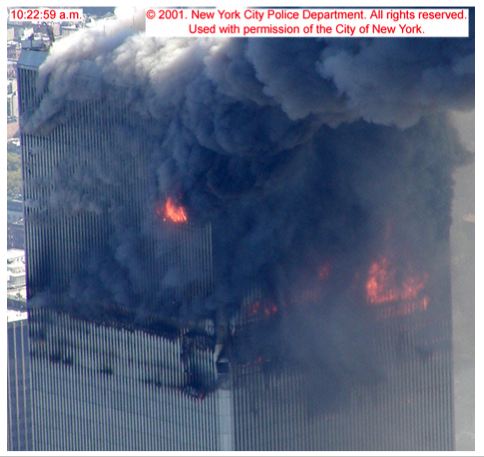
Originally posted by XenonCodex
How about those Cardington Steel tests?
How about them?
Perhaps you can explain how they apply to the design and construction of the WTC towers.
What kind of floor framing did they test at Cardington?
What kind of floor framing did the WTC towers use?
Originally posted by XenonCodex
Maybe someone should try and find a construction worker that is still around and find out from them if the steel uprights were encased in concrete. From what I saw on my WTC video it appeared as if they were being prepared for encasement, but I could be wrong.
It's called sprayed on fireproofing.
The contractor that installed it was known to be associated with a certain Mr. Gotti. (but, hey, you got a problem with that? )
There were a number of problems with the application. Namely that there was so much rust and scale on the steel before they applied the fireproofing that it kept falling off.
Here is one of the core area columns, the damaged to the fireproofing was first surveyed in 92:

Here are some shots of the damage to the fireproofing well before 9/11:
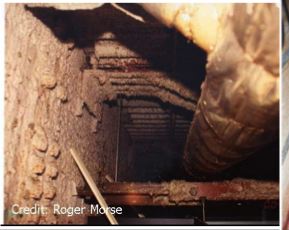
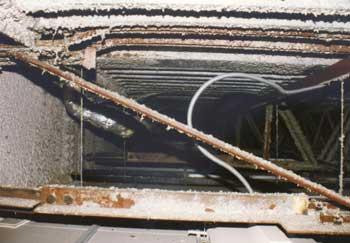
This isn't even considering how much the shock and force of the impact would have knocked off the trusses.
How long would the trusses been able to withstand the fires if they weren't fireproofed?
fire-research.group.shef.ac.uk...

The FEMA report (2002) estimated that approximately 4000 gallons of airplane fuel may have
remained on the impact floors of WTC1. If this is assumed to have been evenly distributed over 5
damaged floors in WTC1, the increase of the fire load due to the fuel may not have been significant
different from the generic office fire load (EC1t1.2 1991). The opening factor, dependent on the local
aircraft impact damage, varies between floors, but was still relatively low due to the large ratio of floor
area to storey height. Therefore, the ISO834 (1975) fire was applied in order to assess the temperature
development of the composite truss. The influence of the active sprinkler protection system was not
included since this was almost certainly inactive or ineffective. The long-span composite trusses in the
twin towers were assumed to be insulated under normal conditions to resist 2 hours of the standard fire
by a prescriptive method. Due to the airplane impact and blast, very little of the extremely fragile
sprayed insulation material would have remained intact on the surface of many trusses. Hence, an
unprotected composite truss was considered as a reasonable lower-bound case.
In the unprotected case, the temperature development of each of the chords (Fig 2) was calculated using
the section factor, Am/V, using the formula provided by EC4: Pt1.2 (ECS 1994). The column was still
assumed to be protected.

To simulate the top and bottom floors of the fire-exposed levels, the structural behaviour of protected
and unprotected composite trusses with a supporting column was investigated under the 4.8kN/m2 and
3.9kN/m2 loadings for 60 minutes’ exposure to the standard fire. The performance of the models is
shown, in Fig 6, in terms of the vertical deflection of the mid-span top chord against time.
The variation of the horizontal reaction at the beam-column connection, under the arbitrary loading, is
plotted in Fig 7. Fig 6 shows that the protected models resist 60 minutes of the standard fire with
deflection of about L/90. During this period, the column consistently experiences a push-out force (Fig.
7) due to thermal elongation of the slab and top chord.
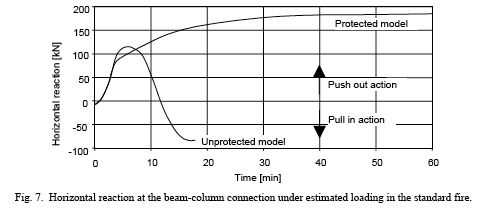
Unprotected simply supported trusses
initially lost stability at 12.5 and 13.4 minutes due to buckling of the second compressive web diagonal.
Both of the protected trusses with a supporting column deflected approximately L/90 at 60 minutes of
the standard fire without any local instability occurring. The unprotected composite truss with a
supporting column was shown to resist for 16.1 and 18.0 minutes of the standard fire before the
progressive buckling of web compression diagonals caused a loss of stability. This would undoubtedly
have re-stabilised when catenary action of the top chord and slab reinforcement took effect, but their
tensile strength, together with the tying strength of the beam-column connections, would then become
critical. For both types of support condition the behaviour of the unprotected truss was relatively
insensitive to the level of loading.
So you can see by that analysis, the floor trusses would have sagged and failed, destabilizing the exterior columns. The exterior columns would have then become susceptible to buckling, not because of the temperature that they were exposed to, but because of the loss of the horizontal pinning action formerly provided by the floors.

Originally posted by craig732
Anybody hear live in New York City? If so, drive down the West Side Highway, and at about 96th street you will see what remains of a warehouse pier. The pier caught fire. What is left is a pile of twisted metal beams. Metal weakens and twists relatively easy when it is heated.
I am re-posting this because many people seemed to have missed it. Steel does not have to be MELTED to weaken, bend, sag, stress, twist, or misshape. Just heating steel to temperatures as low as 350 degrees causes it to expand slightly and weaken.
You can do this experiment at your next campfire: Throw a 16" peice of leaf-spring (available at any junkyard) into a campfire and within about 1/2 hour it will glow red and slightly bend/curl.
Here is some interesting information.
source

It looks like in real life fires, the temperatures can easily exceed that of the standard time and temperature curve.
Traditionally the fire resistance of structural members has been determined in Standard Fire Tests. The time-temperature environment in the Standard Fire Test represents a more severe heating condition compared to that in many typical natural fire compartments. In a well-ventilated compartment the duration and/or the severity of the time-temperature environment is generally less than in a Standard Fire Test. The effect of ventilation and fire load on fire severity is illustrated in Figure 2. Fire tests were conducted in compartments where the fire load and the natural ventilation were varied. The well ventilated compartments experienced lower temperatures and fires of shorter duration. In Figure 2 the numbers identified with each curve indicate the fire load density in kg/m2 (ie 60, 30 or 15) and the ventilation area as a proportion of the façade area (ie ½ or ¼).
The compartments used in the tests were small by modern standards but the results are indicative of the influence of fire load and ventilation on the time-temperature environment generated within fire compartments.
source

It looks like in real life fires, the temperatures can easily exceed that of the standard time and temperature curve.
the dust
[ext]The new work helps explain the very fine particles and extraordinarily high concentrations found by an earlier UC Davis study, the first to identify very fine metallic aerosols in unprecedented amounts from Ground Zero. It will be essential to understanding the growing record of health problems. [/ext]
[ext]The debris pile acted like a chemical factory. It cooked together the components of the buildings and their contents, including enormous numbers of computers, and gave off gases of toxic metals, acids and organics for at least six weeks."
[/ext]
[ext]When the trade center towers burned and collapsed, tons of concrete, glass, furniture, carpets, insulation, computers and paper were reduced to enormous, oxygen-poor debris piles that slowly burned until Dec.19, 2001. [/ext]
[ext]The new work helps explain the very fine particles and extraordinarily high concentrations found by an earlier UC Davis study, the first to identify very fine metallic aerosols in unprecedented amounts from Ground Zero. It will be essential to understanding the growing record of health problems. [/ext]
[ext]The debris pile acted like a chemical factory. It cooked together the components of the buildings and their contents, including enormous numbers of computers, and gave off gases of toxic metals, acids and organics for at least six weeks."
[/ext]
[ext]When the trade center towers burned and collapsed, tons of concrete, glass, furniture, carpets, insulation, computers and paper were reduced to enormous, oxygen-poor debris piles that slowly burned until Dec.19, 2001. [/ext]
Originally posted by craig732
Anybody hear live in New York City? If so, drive down the West Side Highway, and at about 96th street you will see what remains of a warehouse pier. The pier caught fire. What is left is a pile of twisted metal beams. Metal weakens and twists relatively easy when it is heated.
How long did it burn and what percentage of the building was affected by the fire? The wtc burned for a mere 59 minutes and about a mere 5% of the building if that was even touched by fire.
I am re-posting this because many people seemed to have missed it. Steel does not have to be MELTED to weaken, bend, sag, stress, twist, or misshape. Just heating steel to temperatures as low as 350 degrees causes it to expand slightly and weaken.
You can do this experiment at your next campfire: Throw a 16" peice of leaf-spring (available at any junkyard) into a campfire and within about 1/2 hour it will glow red and slightly bend/curl.
Right.
Then why doesn't your bar-b-q or even just the grill in it melt?
How is that leaf-spring comparable to STRUCTURAL STEEL in any way? Think you could get structural steel to melt that fast in a campfire?
I've tried that experiment with a key and it didn't change shape after being in the fire all night and still worked in the morning!
Plus your "experiment" is an irrelevant analogy to the wtc because the fires only consumed about 5% of the entire building if that for a mere hour, yet your "leaf-spring" would have to be entirely engulfed in flames.
Sorry but when you are talking about structural steel core columns columns this big.....
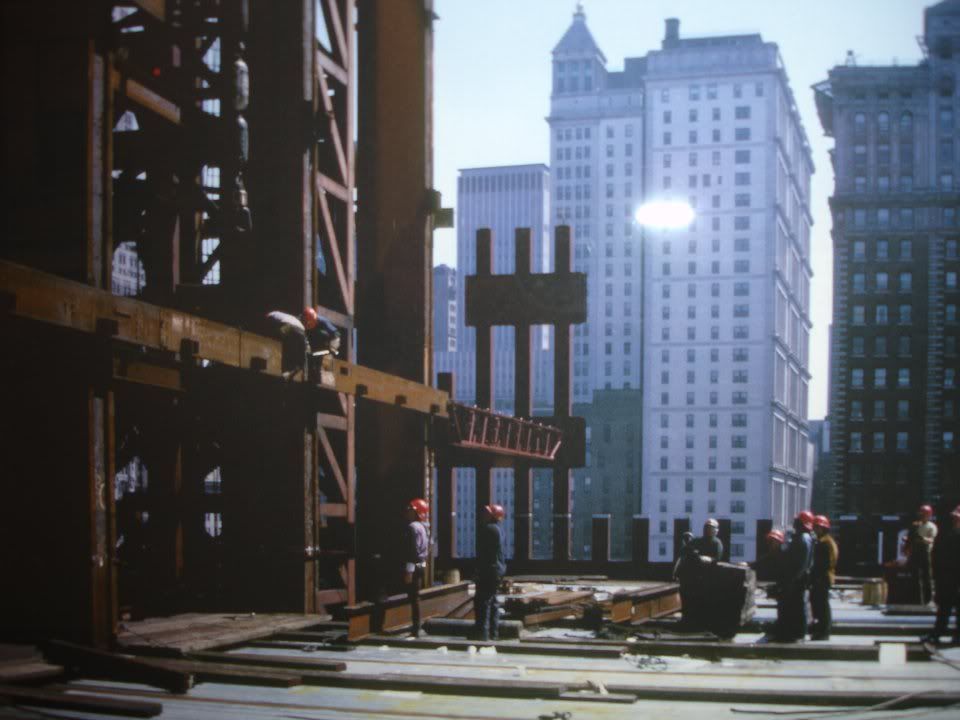
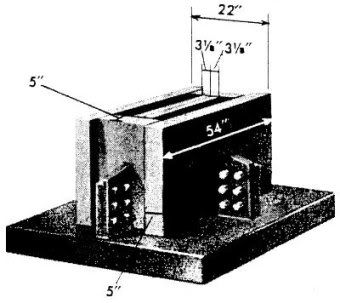
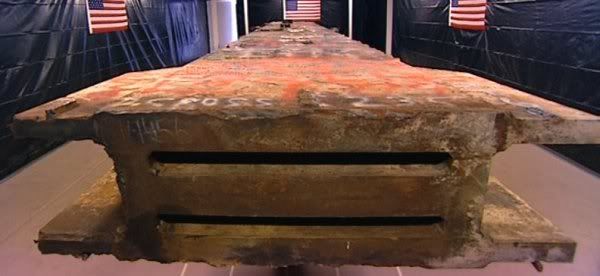
And considering the fact that the fires were limited to an area this small in comparison to the unaffected portions of the building allowing for the rest of the undamaged part of the buildings to act as a heat sink....
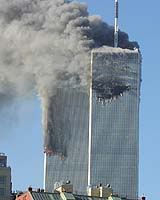
not only is your campfire analogy rendered moot but the fact that the steel weakened enough to collpase is shown to be absurd.
And where did you come up with the ridiculous 350 degree number??? You better source that because I have sources that say it is patently false.
Even if you are talking Celcius! (which you did not specify so I will assume you meant Fahrenheit which is even more absurd because your stove would melt when you bake a cake if that were true!)

"It is known that structural steel begins to soften around 425 C and loses about half of it's strength at 650 C."
"Even with its strenghth halved, the steel could still support two to three times the stresses imposed by a 650 C fire"
There is no possible way that the STEEL reached temperatures that height in a mere hour from a "diffuse flame" fire that feeds off air.
Impossible.
Here is another factual point that is oft ignored by official story enthusiats.
The south tower was not hit directly so most of the jet fuel burned OUTIDE of the building.
Despite this fact the south tower, which was hit 2nd, collapsed first in a mere 59 minutes after impact!!!
How could this be?

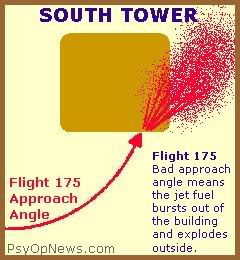
The south tower was not hit directly so most of the jet fuel burned OUTIDE of the building.
Despite this fact the south tower, which was hit 2nd, collapsed first in a mere 59 minutes after impact!!!
How could this be?


This air explosion provided a stunning pyrotechnic spectacle witnessed by countless millions, but it was an operational disaster. For it left the thorny question of explaining how the South Tower -which took less than half the fuel load of its North Tower twin -was the first of the two to collapse.
Here is more information about the "imagined heat" of the steel and why the NIST report is so contradictory.....
Imagined Heat
The Report repeatedly makes claims that amazingly high fire temperatures were extant in the Towers, without any evidence. The Report itself contains evidence contradicting the claims.
Observations of paint cracking due to thermal expansion. Of the more than 170 areas examined on 16 perimeter column panels, only three columns had evidence that the steel reached temperatures above 250 ºC: east face, floor 98, inner web; east face, floor 92, inner web; and north face, floor 98, floor truss connector. Only two core column specimens had sufficient paint remaining to make such an analysis, and their temperatures did not reach 250 ºC. ... Using metallographic analysis, NIST determined that there was no evidence that any of the samples had reached temperatures above 600 ºC. (p 90/140)
The highest temperatures estimated for the samples was 250 ºC (482 ºF). That's consistent with the results of fire tests in uninsulated steel-framed parking garages, which showed maximum steel temperatures of 360 ºC (680 ºF). How interesting then, that NIST's sagging truss model has the truss heated to 700 ºC (1292 ºF).
A floor section was modeled to investigate failure modes and sequences of failures under combined gravity and thermal loads. The floor section was heated to 700 ºC (with a linear thermal gradient through the slab thickness from 700 ºC to 300 ºC at the top surface of the slab) over a period of 30 min. Initially the thermal expansion of the floor pushed the columns outward, but with increased temperatures, the floor sagged and the columns were pulled inward. (p 98/148)
Where does NIST get the idea that steel temperatures should be more than 450 degrees Celsius (or 842 degrees Fahrenheit) higher than their own evidence indicates? This passage provides some insight into their experimental method.
A spray burner generating 1.9 MW or 3.4 MW of power was ignited in a 23 ft by 11.8 ft by 12.5 ft high compartment. The temperatures near the ceiling approached 900 ºC. (p 123/173)
1.9 to 3.4 MW (megawatts) is the heat output of about 500 wood stoves -- that in a living-room-sized space!
The jet fuel greatly accelerated the fire growth. Only about 60 percent of the combustible mass of the rubblized workstations was consumed. The near-ceiling temperatures varied between 800 ºC and 1,100 ºC. (p 125-6/175-6)
Temperatures of 800 ºC to 1,100 ºC (1472 ºF to 2012 ºF) are normally observed only for brief times in building fires, in a phenomenon known as flashover. Flashover occurs when uncombusted gases accumulate near the ceilings and then suddenly ignite. Since flame consumes the pre-heated fuel-air mixture in an instant, very high temperatures are produced for a few seconds. Note that this temperature range includes the 900 ºC recorded using the megawatt super-burner, so they must have had to pour on quite a lot of jet fuel.
The first section of the Report describing the fires deceptively implies that 1,000 ºC (1832 ºF) temperatures (rarely seen in even momentary flashovers) were sustained, and that they were in the building's core.
Aside from isolated areas, perhaps protected by surviving gypsum walls, the cooler parts of this upper layer were at about 500 ºC, and in the vicinity of the active fires, the upper layer air temperatures reached 1,000 ºC. The aircraft fragments had broken through the core walls on the 94th through the 97th floors, and temperatures in the upper layers there were similar to those in the tenant spaces. (p 28/78)
Note the absurdity of asserting that the fires in the core were as intense as those in the tenant spaces when the core:
* Had very little fuel
* Was far from any source of fresh air
* Had huge steel columns to wick away the heat
* Does not show evidence of fires in any of the photographs or videos
Furthermore, NIST's suggestion of extremely high core temperatures is contradicted by its own fire temperature simulations, such as the one illustrated on the right, which show upper-level air temperatures in the core of mostly below 300 ºC.
source
from that same thermal image from nist, notice how the alleged 1000C temperatures are flush with a large percentage of the perimeter columns?
well, the aluminum would be running off the outside of the building in molten form if those perimeter columns ACTUALLY got NEAR that hot.
well, the aluminum would be running off the outside of the building in molten form if those perimeter columns ACTUALLY got NEAR that hot.
Well, the one-two-three punch for me was the NIST damage pattern (not enough damage), the dropping of the maximum temperature to around 200 C, coupled
with the statement
"no structural element was exposed to fire for the entire time".
Sorry - that won't get us where we need to be if we're trying to achieve total failure.
"no structural element was exposed to fire for the entire time".
Sorry - that won't get us where we need to be if we're trying to achieve total failure.
Originally posted by billybob
well, the aluminum would be running off the outside of the building in molten form if those perimeter columns ACTUALLY got NEAR that hot.
Not only that, but the columns themselves would be glowing brightly in broad daylight.
Never happened.
In the case of the WTC towers, the exterior columns were pinned at each floor by the rigid floors.
For columns and struts with pinned ends, the theoretical compressive load for buckling is given by the Euler Formula

where
Pcrit = critical load at which the column will fail.
L = length of column
E = Young's Modulus
I = second moment of area
Going back to the analysis that I referenced earlier, unprotected floor trusses would have been rapidly heated under standard time and temperature curve conditions.

This would have, in turn, caused the floor truss to rapidly destabilize.

You posted the NIST models showing the following 15 minutes after impact.
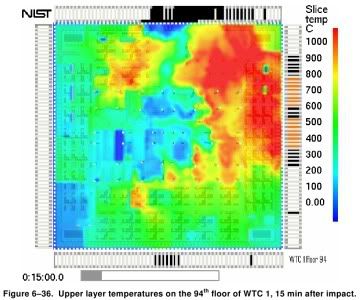
However, if you look at the models for 30 and 45 minutes after the impact, you can clearly see that significant portions of the floor trusses were exposed to temperatures in the 1000° C range well past the point where they would be expected to fail. It is also clear thatthe fires, as modeled by NIST are also more intense than the standard fire tests.

source
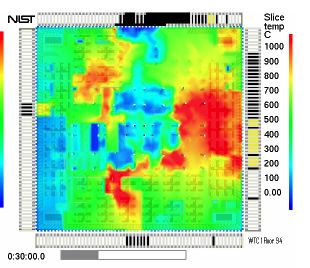

And, As I demonstrated before, the fireproofing on the floor trusses was in poor shape before 9/11.


This is not even considering the damage to the friable fireproofing that would have occurred with the force of the impact. Nor am I even considering the probable damage to the floor trusses from the impact.
Now I can just hear some of you wondering, "so what?"
Well, if, the floors start to fail like so:

then those floors are no longer pinning the columns in place. (in fact, they are pulling the columns inward, but we will ignore that for now.)
Thus, the only thing that changes on the right side of the equation is the effective length of the column, which increases each time a floor fails.

That would be L in the above equation.
Some of you may have already recognized that that equation is an example of an inverse square law.
What this means is that if a single floor fails, the critical buckling load for that group of columns has now been reduced to 25 per cent of it's former value.
If three consecutive floors fail, the critical load at which the column will buckle is now 1/9th or 11% of its original value. Lose 4 floors and you are down to 6.25% of the original value.
So, in short, It makes no difference whatsoever how hot the exterior columns got. They buckled because the internal support, the floor slabs failed due to the loss of the protective fireproofing and the intense heat of the fires.
For columns and struts with pinned ends, the theoretical compressive load for buckling is given by the Euler Formula

where
Pcrit = critical load at which the column will fail.
L = length of column
E = Young's Modulus
I = second moment of area
Going back to the analysis that I referenced earlier, unprotected floor trusses would have been rapidly heated under standard time and temperature curve conditions.

This would have, in turn, caused the floor truss to rapidly destabilize.

You posted the NIST models showing the following 15 minutes after impact.

However, if you look at the models for 30 and 45 minutes after the impact, you can clearly see that significant portions of the floor trusses were exposed to temperatures in the 1000° C range well past the point where they would be expected to fail. It is also clear thatthe fires, as modeled by NIST are also more intense than the standard fire tests.

source


And, As I demonstrated before, the fireproofing on the floor trusses was in poor shape before 9/11.


This is not even considering the damage to the friable fireproofing that would have occurred with the force of the impact. Nor am I even considering the probable damage to the floor trusses from the impact.
Now I can just hear some of you wondering, "so what?"
Well, if, the floors start to fail like so:

then those floors are no longer pinning the columns in place. (in fact, they are pulling the columns inward, but we will ignore that for now.)
Thus, the only thing that changes on the right side of the equation is the effective length of the column, which increases each time a floor fails.

That would be L in the above equation.
Some of you may have already recognized that that equation is an example of an inverse square law.
What this means is that if a single floor fails, the critical buckling load for that group of columns has now been reduced to 25 per cent of it's former value.
If three consecutive floors fail, the critical load at which the column will buckle is now 1/9th or 11% of its original value. Lose 4 floors and you are down to 6.25% of the original value.
So, in short, It makes no difference whatsoever how hot the exterior columns got. They buckled because the internal support, the floor slabs failed due to the loss of the protective fireproofing and the intense heat of the fires.
Howard, just wondering...
Who are you trying to convince anymore?
Thanks.
PS - We know what NIST is suggesting. They make too many unsupported assumptions to be taken seriously. Maybe post some actual evidence next time.
Who are you trying to convince anymore?
Thanks.
PS - We know what NIST is suggesting. They make too many unsupported assumptions to be taken seriously. Maybe post some actual evidence next time.
here's a trick...
put a bunch of weight on something and that added FRICTION holds it in place with greater strength. the floors did not support any vertical load, and any horizontal force that they could exert on the perimeter columns would be insignifigant to the UNAFFECTED columns, which represented 85%.
the uncompromised columns would be under increased compression from taking the added stress of the missing columns. the increased load on the unaffected columns of the damaged floors would effectively make them more resistant to horizontal forces.
so, once again, the pancakes are served in a house of cards.
don't buy the lie, folks!
put a bunch of weight on something and that added FRICTION holds it in place with greater strength. the floors did not support any vertical load, and any horizontal force that they could exert on the perimeter columns would be insignifigant to the UNAFFECTED columns, which represented 85%.
the uncompromised columns would be under increased compression from taking the added stress of the missing columns. the increased load on the unaffected columns of the damaged floors would effectively make them more resistant to horizontal forces.
so, once again, the pancakes are served in a house of cards.
don't buy the lie, folks!
The problem is, Howard, that this...
isn't pulling anything inward. Just prior to complete failure, the northwest portion of the building is in tension, which makes it very difficult to naturally make it collapse. Now, I can see the northwest portion of the building failing in tension, which would result in partial collapse of floors below the failure point (but on the southeast side of the building due to the center of gravity of the top portion now displaced through an offset vector) and the top going on over, but I'm not intuitively seeing this type of displacement causing the type of total collapse that ensued. That doesn't mean I'm not missing something, that's just to say it is extremely counter-intuitive. In fact, it's painfully counter-intuitive.
EDIT: "the northwest portion of the building is in tension" would be the wrong way to say this. The moment would cause a decrease in the compressive load seen by the n.w. side - but not necessarily throw it into pure tension. Just wanted to make clear what my mis-statement meant.
[edit on 2-20-2006 by Valhall]
isn't pulling anything inward. Just prior to complete failure, the northwest portion of the building is in tension, which makes it very difficult to naturally make it collapse. Now, I can see the northwest portion of the building failing in tension, which would result in partial collapse of floors below the failure point (but on the southeast side of the building due to the center of gravity of the top portion now displaced through an offset vector) and the top going on over, but I'm not intuitively seeing this type of displacement causing the type of total collapse that ensued. That doesn't mean I'm not missing something, that's just to say it is extremely counter-intuitive. In fact, it's painfully counter-intuitive.
EDIT: "the northwest portion of the building is in tension" would be the wrong way to say this. The moment would cause a decrease in the compressive load seen by the n.w. side - but not necessarily throw it into pure tension. Just wanted to make clear what my mis-statement meant.
[edit on 2-20-2006 by Valhall]
Originally posted by billybob
here's a trick...
put a bunch of weight on something and that added FRICTION holds it in place with greater strength.
Um, not necessarily. If two surfaces are in contact in an inclined plane, then adding more weight to the top surface will eventually overcome the friction.
But anyway. . . What are you talking about here?
Originally posted by billybob
the floors did not support any vertical load,
WHAT?
Originally posted by billybob
and any horizontal force that they could exert on the perimeter columns would be insignifigant to the UNAFFECTED columns, which represented 85%.
Where did you come up with this 85% number? I’m not talking about the columns directly damaged be the impact. I’m talking about columns that were pulled out of alignment when the floors slabs failed as the fires burned.
Originally posted by billybob
the uncompromised columns would be under increased compression from taking the added stress of the missing columns. the increased load on the unaffected columns of the damaged floors would effectively make them more resistant to horizontal forces.
Where did you come up with that theory?
Go back to the EUler formula:

Note that Pcrit is the point at which the column will buckle under the existing load. If the existing load stays the same, but the effective length keeps getting longer, the existing load will eventually exceed the Pcrit load and the column will fail.
Note the term E in the above formula. That is the modulus of elasticity. also know as Young’s modulus.
Unfortunately for your theory, steel is known to have a linear modulus of elasticity. That is, it remains constant over a range of strains. (i.e. it follows Hooke’s Law).
Actually it works the other way around.
A tensile (positive) force acts to stiffen a beam in the transverse direction. A compressive (negative) force reduces the transverse stiffness
source
Originally posted by billybob
don't buy the lie, folks!
Don’t buy a building designed by billybob, folks!
when you have weight pushing down on something, ANYTHING, it effectively increases the mass of that object. the columns which were intact would be
harder to move sideways because of the added mass.
when they begin to reach the CRITICAL point, elasticity becomes RELAVENT. until that moment in time, the perimeter columns have effectively increased their mass, and are harder to push sideways, as their strength is mostly uncompromised, as testified by the LACK OF MOLTEN ALUMINUM RUNNING DOWN THE SIDES.
NIST would have us believe that the critical point was reached simultaneously across the whole perimeter and core for BOTH towers. BS say all of us. it was BOMBS, as evidenced by the SOUND OF BOMBS(911eyewitness video), and the upward ejections of debris, and the ultrafine dust and vapourised metal, and molten steel 'running' for weeks in the rubble pile.
not to mention the UNPRECEDENTED media COMPLETELY IGNORING tower seven, which was even MORE OBVIOUSLY bombed into an instant rubble pile.
if you buy a building from howard, DON'T 'pull' the bomb-sniffing dogs.
when they begin to reach the CRITICAL point, elasticity becomes RELAVENT. until that moment in time, the perimeter columns have effectively increased their mass, and are harder to push sideways, as their strength is mostly uncompromised, as testified by the LACK OF MOLTEN ALUMINUM RUNNING DOWN THE SIDES.
NIST would have us believe that the critical point was reached simultaneously across the whole perimeter and core for BOTH towers. BS say all of us. it was BOMBS, as evidenced by the SOUND OF BOMBS(911eyewitness video), and the upward ejections of debris, and the ultrafine dust and vapourised metal, and molten steel 'running' for weeks in the rubble pile.
not to mention the UNPRECEDENTED media COMPLETELY IGNORING tower seven, which was even MORE OBVIOUSLY bombed into an instant rubble pile.
if you buy a building from howard, DON'T 'pull' the bomb-sniffing dogs.
Originally posted by HowardRoark
Originally posted by billybob
the floors did not support any vertical load,
WHAT?
The floors weren't designed to hold any of the dead load, which is what I'm assuming BillyBob meant. The slabs/trusses held the live loads of their individual floors, but that's it. The rest was lateral load from wind, etc. upon the trusses from the perimeter columns.
And let's not suggest that the support columns were set up by floor, Howard. That would be deceiving people.
Where did you come up with this 85% number? I’m not talking about the columns directly damaged be the impact. I’m talking about columns that were pulled out of alignment when the floors slabs failed as the fires burned.
Oh, so you mean 0%.
You should stop running with theories as if they were facts. NIST has suggested what you are suggesting, but they haven't supported it, and it's only one theory of how the collapse initiated. Especially considering there's absolutely nothing to support the idea, I have no idea where you get off thinking you could post such info as factual.
Valhall just brought up an old problem that you still haven't addressed, too, but I guess you're saving that response for later, when all of this garbage has faded from memory and you could pull some doublethink magic. After all, the angular momentum problem doesn't fit very well with the truss failure theory, as Valhall also pointed out.
But which did we actually observe on 9/11? A truss failure from super-heated concrete and steel and etc. etc. (which wasn't even glowing -- you didn't bother addressing that either, but completely sidetracked to dazzle us with technical jargon ), or a disappearance of angular momentum? There's a pic just above here of WTC2 leaning, so hopefully that will refresh your memory as you respond. But then again, I know memory has nothing to do with it. It's all to do with $$, isn't it Howie? Total pro, lmao.
new topics
-
Electrical tricks for saving money
Education and Media: 39 minutes ago -
VP's Secret Service agent brawls with other agents at Andrews
Mainstream News: 1 hours ago -
Sunak spinning the sickness figures
Other Current Events: 2 hours ago -
Nearly 70% Of Americans Want Talks To End War In Ukraine
Political Issues: 2 hours ago -
Late Night with the Devil - a really good unusual modern horror film.
Movies: 4 hours ago -
Cats Used as Live Bait to Train Ferocious Pitbulls in Illegal NYC Dogfighting
Social Issues and Civil Unrest: 6 hours ago -
The Good News According to Jesus - Episode 1
Religion, Faith, And Theology: 7 hours ago -
HORRIBLE !! Russian Soldier Drinking Own Urine To Survive In Battle
World War Three: 10 hours ago
top topics
-
SETI chief says US has no evidence for alien technology. 'And we never have'
Aliens and UFOs: 16 hours ago, 8 flags -
Cats Used as Live Bait to Train Ferocious Pitbulls in Illegal NYC Dogfighting
Social Issues and Civil Unrest: 6 hours ago, 8 flags -
Florida man's trip overseas ends in shock over $143,000 T-Mobile phone bill
Social Issues and Civil Unrest: 12 hours ago, 8 flags -
VP's Secret Service agent brawls with other agents at Andrews
Mainstream News: 1 hours ago, 6 flags -
Former Labour minister Frank Field dies aged 81
People: 15 hours ago, 4 flags -
Bobiverse
Fantasy & Science Fiction: 12 hours ago, 3 flags -
HORRIBLE !! Russian Soldier Drinking Own Urine To Survive In Battle
World War Three: 10 hours ago, 3 flags -
Nearly 70% Of Americans Want Talks To End War In Ukraine
Political Issues: 2 hours ago, 3 flags -
Sunak spinning the sickness figures
Other Current Events: 2 hours ago, 3 flags -
Late Night with the Devil - a really good unusual modern horror film.
Movies: 4 hours ago, 2 flags
active topics
-
Cats Used as Live Bait to Train Ferocious Pitbulls in Illegal NYC Dogfighting
Social Issues and Civil Unrest • 12 • : Hakaiju -
HORRIBLE !! Russian Soldier Drinking Own Urine To Survive In Battle
World War Three • 28 • : budzprime69 -
Huge ancient city found in the Amazon.
Ancient & Lost Civilizations • 61 • : Therealbeverage -
The Reality of the Laser
Military Projects • 43 • : 5thHead -
VP's Secret Service agent brawls with other agents at Andrews
Mainstream News • 16 • : matafuchs -
Should Biden Replace Harris With AOC On the 2024 Democrat Ticket?
2024 Elections • 49 • : Therealbeverage -
WF Killer Patents & Secret Science Vol. 1 | Free Energy & Anti-Gravity Cover-Ups
General Conspiracies • 32 • : Arbitrageur -
Is there a hole at the North Pole?
ATS Skunk Works • 38 • : Therealbeverage -
SETI chief says US has no evidence for alien technology. 'And we never have'
Aliens and UFOs • 41 • : TheMisguidedAngel -
Naked Eye Supernova Erupting in the T Coronae Borealis
Space Exploration • 13 • : Therealbeverage
